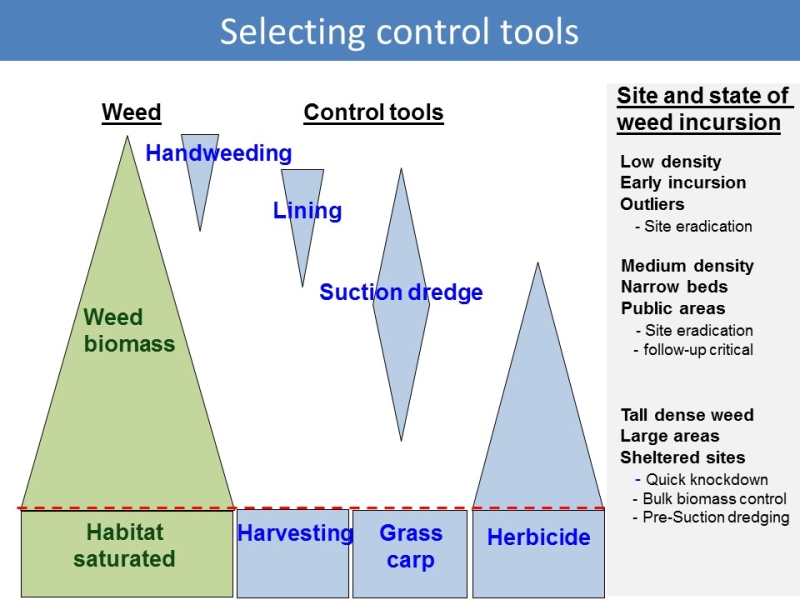A succession of aquatic plants have been introduced into New Zealand primarily for ornamental and aesthetic reasons through the aquarium trade, and subsequently spread either deliberately or accidentally by people.
Alien submerged aquatic plants have had spectacular success in invading New Zealand lakes, often forming dense mono-specific stands of vegetation described here as weed beds. Dense weed beds displace desirable native plants, and can result in low levels of dissolved oxygen that locally degrade fish and wildlife habitat. Weed beds reduce amenity values such as such as swimming, angling and boat access, and plant material washed ashore by wind and wave action (later putrefying on the beaches) reduces the aesthetic value of the lakes. Utility values may also be compromised by dense weed beds. For example floating rafts of dislodged weed have caused the shut-down of hydro-electric power stations, and weed beds in drainage and irrigation canals can impeded the flow of water.
Once a weed species or weed issue has been recognised, control options are often sought to protect amenity and utility functions of susceptible lakes or waterways. There is also a growing desire to control invasive plants to support the restoration of lakes for intrinsic values, such as improving biodiversity and habitat. There are six general categories of control methods for invasive aquatic plants: habitat manipulation, biological, chemical, mechanical and manual control, and integrated weed control. The selection of method (or methods) is primarily determined by the target weed, characteristics of the lake or waterbody and the management goals or desired outcome (Figure 1).
Herbicides can be used to provide effective, selective and targeted weed control. Two products, diquat (diquat dibromide, Reglone®) and endothall (dipotassium endothall, Aquathol K®), are registered in New Zealand for use on submerged aquatic weeds. Both products are contact herbicides with a long history of use, but the products differ in terms of where or when they are best used. Plants may differ in their susceptibility to each product, which means that knowledge of the appropriate CET (contact and exposure time relationship) for a target weed, compared with any desirable native plants present in the waterbody can enable selective herbicide use. For example, diquat is commonly used to control the invasive weeds egeria (Egeria densa), lagarosiphon (Lagarosiphon major) and hornwort (Ceratophyllum demersum), however it does not control the weed hydrilla (Hydrilla verticillata) and it is rapidly deactivated by clay and charged sediment particles in the water or on plant surfaces. By comparison endothall is effective on hydrilla, lagarosiphon and hornwort, but not on egeria. Removal of invasive species weed beds can promote the return of native plants and associated fauna. In addition some groups of plants, such as native charophytes, are not affected by diquat or endothall. Targeted weed control is achieved not only by selecting the most appropriate product, but also the application method. Research aimed at improving product placement and tracking in waterways has led to reduced herbicide use and more predictable weed control outcomes.
More information
Presentations from the Lake Water Quality Society Symposium will be made available on the Lake Water Quality Society website


